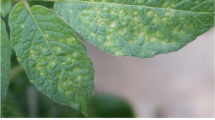Abstract
Field-grown wild tobacco plants (Nicotiana sylvestris) were subjected to a defoliation regime designed to mimic the rate and amount of leaf mass removed by one tobacco hornworm per plant. Undamaged leaves on these plants undergo a dramatic (457% for leaf position 5, 410% for leaf position 8) increase in total leaf alkaloids compared to same-age and positioned control leaves on undamaged control plants. However, potted greenhouse-grown plants fail to exhibit the same damage-induced increase in alkaloid content. The greenhouse environment differs from the field environment in factors known to influence leaf alkaloid content, particularly soil N, P, K, near-UV radiation, and relative humidity. However, altering these environmental factors does not make potted plants able to increase their leaf alkaloid levels in response to defoliation. Transplanting plants into larger pots with more soil does allow the plants to respond to defoliation. Thirty days after transplanting, the plants are again unresponsive to damage, probably as a result of becoming “pot-bound.” This result suggests a mechanism for the induction response, specifically that leaf damage triggers synthesis of these alkaloids in the roots, and offers a potentially valuable experimental tool for the study of induced-plant defenses in tobacco and other plants that synthesize alkaloids in their root tissues.
Similar content being viewed by others
References
Anderson, R., andKasperbauer, M.J. 1973. Chemical composition of tobacco leaves altered by near UV and intensity of visible light.Plant Physiol. 51:723–726.
Boodley, J.W., andSheldrake, R., Jr. 1977. Cornell peat-lite mixes for commercial plant growing. Cornell Information Bulletin No. 43, 17 pp.
Bose, B.C., De, H.N., Dalal, I.H. andMohammad, S. 1956. Biogenesis of alkaloids in tobacco plants.J. Indian Med. Res. 44:81–89.
Dewey, L.J., Byerrum, R.U., andBall, C.D. 1955. Biosynthesis of the pyrrolidine ring of nicotine.Biochim. Biophys. Acta 18:141–142.
Gordon, H.T. 1961. Nutritional factors in insect resistance to chemicals.Annu. Rev. Entomol. 6:27–54.
Hassal, C.A. 1969.World Crop Protection 2:128–130, 138.
Haukioja, E. 1982. Inducible defenses of white birch to a geometrid defoliator,Epirrita autumnata. Proc. 5th Int. Symp. Insect-Plant Relationships. Wageningen (PUDOC), pp. 199–203.
Madden, A.H. 1945. Biology of the tobacco hornworm in the southern cigar-tobacco district. USDA Technical Bulletin No. 896, 55 pp.
Mizusaki, S., Tanabe, Y., Roguchi, M., andTamaki, E. 1973. Changes in the activities of ornithine decarboxylase putrescinen-methyl transferase andn-methyl putrescine oxidase in tobacco roots in relation to nicotine biosynthesis.Plant Cell Physiol. 14:103–110.
Mothes, K. 1960. Alkaloids in the plants, pp. 1–29,in R.H.F. Manske (ed.). The Alkaloids, Chemistry and Physiology, Vol. VI. Academic Press, New York.
Parr, J.C., andThurston, R. 1972. Toxicity of nicotine in synthetic diets to larvae of the tobacco hornworn.Ann. Entomol. Soc. Am. 65:1185–1188.
Reuter, V.G. 1957. Zustandsbedingte Produktionsanderungen spezifischer Stickstoff-Verbindungen in der Tabak pflanze.Die Kulturpflanze 5:137–185.
Rhoades, D.F. 1979. Evolution of plant chemical defense against herbivores, pp. 4–54,in G.A. Rosenthal and D. H. Janzen (eds.). Herbivores: Their Interactions with Secondary Compounds. Academic Press, New York.
Rosa, N. 1973. Sampling ofNicotiana tabacum leaf lamina to surmount the problem of nonuniform distribution of total alkaloids.Can. J. Bot. 51:289–291.
Ryan, C.A. 1983. Insect-induced chemical signals regulating natural plant protection responses, p. 43,in R.F. Denno andM. McClure (eds.). Variable Plants and Herbivores in Natural and Managed Systems. Academic Press, New York.
Ryan, T.A., Jr., Joiner, B.L., andRyan, B.F. 1982. Minitab Reference Manual. Minitab, Inc., State College, Pennsylvania.
Saitoh, F., Noma, M., andKawashima, N. 1985. The alkaloid contents of sixtyNicotiana species.Phytochemistry 24:477–480.
Saunders, J.A., andBlume, D.E. 1981. Quantitation of major tobacco alkaloids by high-performance liquid chromatography.J. Chromatogr. 205:147–154.
Schmetz, I. 1971. Nicotine and other tobacco alkaloids, pp. 99–136,in M. Jacobson and D. G. Crosby (eds.). Naturally Occurring Insecticides. Marcel Dekker, New York.
Schultz, J.C., andBaldwin, I.T. 1982. Oak leaf quality declines in response to defoliation by gypsy moth larvae.Science 217:149–151.
Self, L.S., Guthrie, F.E., andHodgson, E. 1964. Adaptation of tobacco hornworms to the ingestion of nicotine.J. Insect Physiol. 10:907–914.
Sokal, R.R., andRohlf, F.J. 1981. Biometry, 2nd ed. W.H. Freeman, San Francisco. 859 pp.
Tso, T.C. 1972.Physiology and Biochemistry of Tobacco Plants. Dowden, Hutchinson and Ross, Stroudsburg, Pennsylvania.
Valentine, H.T., Wallner, W.E., andWargo, P.M. 1983. Nutritional changes in host foliage during and after defoliation, and their relation to the weight of gypsy moth pupae.Oecologia 57:298–302.
Wagner, M.R., andEvans, P.D. 1985. Defoliation increases nutritional quality and allelochemics of pine seedlings.Oecologia 67:235–237.
Williams, K.S. andMyers, J.H. 1984. Previous herbivore attack of red alder may improve food quality for fall webworm larvae.Oecologia 63:166–170.
Wink, M. 1983. Wounding-induced increase of quinolizidine alkaloid accumulation in Lupin leaves.Z. Naturforsch 38C:905–909.
Woetz, W.G. 1955. Some effects of topping and suckering flue-cured tobacco. N.C. Agric. Exp. Stan. Tech. Bull. Number 106.
Wolf, F.A., andBates, W.W. 1964. Extent of tobacco root development as related to nicotine content in plant part.Tobacco Sci 8:67–69.
Yoshida, D. 1962. Degradation and translocation of N15-labeled nicotine injected into intact tobacco leaves.Plant Cell Physiol. 3:391–395.
Author information
Authors and Affiliations
Rights and permissions
About this article
Cite this article
Baldwin, I.T. Damage-induced alkaloids in tobacco: Pot-bound plants are not inducible. J Chem Ecol 14, 1113–1120 (1988). https://doi.org/10.1007/BF01019339
Received:
Accepted:
Issue Date:
DOI: https://doi.org/10.1007/BF01019339




